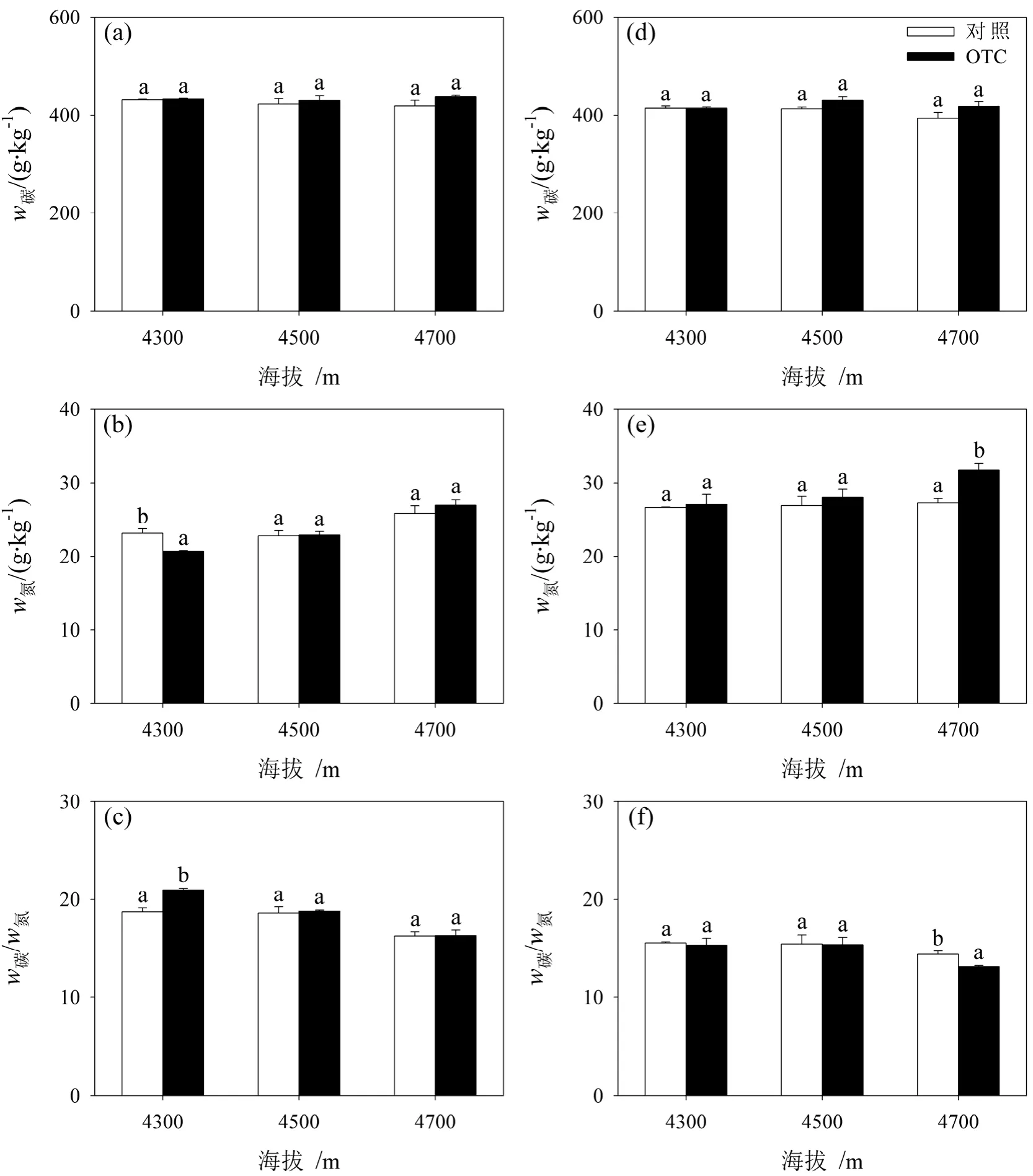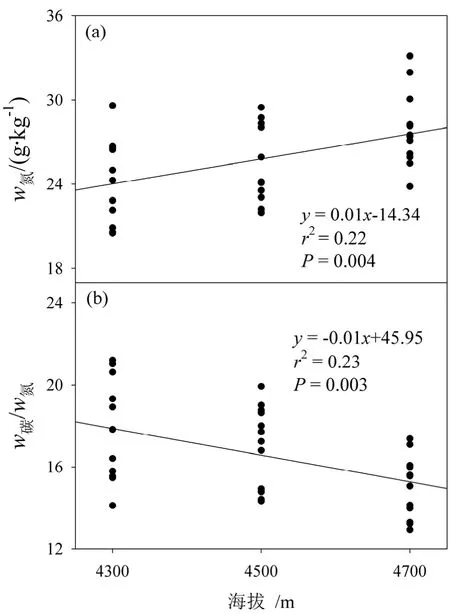藏北高原不同海拔高寒草甸群落地上部分碳氮含量对模拟增温的响应
付刚,孙维,李少伟,何永涛,沈振西
中国科学院地理科学与资源研究所//生态系统网络观测与模拟重点实验室//拉萨高原生态系统研究站,北京 100101
藏北高原不同海拔高寒草甸群落地上部分碳氮含量对模拟增温的响应
付刚,孙维,李少伟,何永涛,沈振西*
中国科学院地理科学与资源研究所//生态系统网络观测与模拟重点实验室//拉萨高原生态系统研究站,北京 100101
摘要:气候变暖影响着高寒植物的生长及其碳含量和氮含量。为了探讨藏北高原高寒草甸群落地上部分碳含量和氮含量对气候变暖的响应,2008年7月在西藏当雄县草原站沿着海拔梯度(即4 300、4 500和4 700 m)布设了一个模拟增温实验(增温方法采用开顶式生长室,开口和底部直径分别为1.00和1.45 m,高度为0.40 m)。通过统计分析三海拔高度上的高寒草甸的2011年7月和2012年7月的群落地上部分碳含量、氮含量和碳氮比,探讨了藏北高原高寒草甸群落地上部分碳含量、氮含量和碳氮比对模拟增温的响应。结果表明,模拟增温显著降低了海拔4 300 m 2011年7月10.5%(2.43 g·kg-1)的氮含量(F=14.95,P=0.018),显著增加了海拔4 300 m 2011年7月12.1%(2.27)的碳氮比(F=22.67,P=0.009);显著增加了海拔4 700 m 2012年7月16.3%(4.44 g·kg-1)的氮含量(F=17.03,P=0.015),显著降低了海拔4 700 m 2012年7月8.6%(1.24)的碳氮比(F=12.60,P=0.024);对三海拔2011年7月(4 300 m:F=0.89,P=0.400;4 500 m:F=0.28,P=0.627;4 700 m:F=2.65,P=0.179)和2012年7月(4 300 m:F=0.000 4,P=0.985;4 500 m:F=4.21,P=0.109;4 700 m:F=2.40,P=0.196)的碳含量都无显著影响;对海拔4 300 m 2012年7月(氮含量:F=0.13,P=0.736;碳氮比:F=0.10,P=0.764)、4 500 m 2011 年7月(氮含量:F=0.01,P=0.912;碳氮比:F=0.12,P=0.750)和2012年7月(氮含量:F=0.48,P=0.525;碳氮比:F=0.004,P=0.951)以及4 700 m 2011年7月(氮含量:F=0.78,P=0.428;碳氮比:F=0.01,P=0.942)的氮含量和碳氮比都无显著影响。因此,模拟增温对高寒草甸群落地上部分碳含量、氮含量和碳氮比的影响随着海拔高度和观测年份发生变化。
关键词:高寒草甸;碳氮含量;海拔梯度;开顶式生长室;藏北高原
引用格式:付刚,孙维,李少伟,何永涛,沈振西. 藏北高原不同海拔高寒草甸群落地上部分碳氮含量对模拟增温的响应[J].生态环境学报, 2015, 24(7): 1093-1097.
FU Gang, SUN Wei, LI Shaowei, HE Yongtao, SHEN Zhenxi. Response of Community Aboveground Parts Carbon and Nitrogen Content to Experimental Warming in An Alpine Meadow at Three Elevations in the Northern Tibet [J]. Ecology and Environmental Sciences, 2015, 24(7): 1093-1097.
青藏高原是气候变暖最敏感的区域之一(Fu et al.,201557;Zhang et al.,201536)。为了探讨高寒植物群落碳含量和氮含量对气候变暖的响应,在青藏高原上已经开展了一些有关模拟增温对植物碳含量和氮含量影响方面的研究(Xu et al.,2009,2012;Yang et al.,2013)。尽管如此,目前并没有一致的结论,即存在增加、减少和无显著变化3种情况(Shi et al.,2014;Yang et al.,2011382;石福孙等,2010492)。此外,在青藏高原上,与土壤碳含量和氮含量相比,有关植物碳含量和氮含量如何响应气候变暖方面的研究相对较少(Fu et al.,201560-61;Zhang et al.,201535),而植物碳含量和氮含量对气候变暖可能更敏感(Bai et al.,2013;Lu et al.,2013730-731)。
青藏高原是气候变暖幅度最大的区域之一,且增温幅度随着海拔的升高而增强(Yao et al.,1991)。最近的整合分析表明,青藏高原上的土壤微生物量碳和氮对模拟增温的响应随着年均温的增大而显著降低,且土壤微生物量氮对模拟增温的响应在一定程度上(P=0.079)与增温幅度有关,而土壤微生物量碳对模拟增温的响应与增温幅度无关(Zhang et al.,2015)35-36。土壤微生物量碳氮比能够间接地反映土壤微生物群落结构(Cookson et al.,2005)。全球尺度上的整合分析表明,植物地上部分碳含量对模拟增温的响应与年均温为显著负相关关系(Lu et al.,2013)733-734。这些研究结果表明,在青藏高原上,土壤微生物量和群落结构对温度升高的响应可能与海拔高度有关。尽管如此,有关青藏高原上的高寒植物群落碳含量和氮含量对气候变暖的响应与海拔高度关系方面的研究还未见报道。
高寒草甸是青藏高原上的典型高寒植被类型之一(Shen et al.,2014)。本研究以西藏自治区拉萨市当雄县草原站的高寒草甸为研究对象,利用开顶式生长室的方式探讨了气候变暖背景下不同海拔高度高寒草甸群落地上部分碳含量、氮含量和碳氮比对模拟增温的响应,以期明确气候变暖对藏北高原高寒草甸群落地上部分碳含量、氮含量和碳氮比的影响。本研究的主要目的是探讨高寒草甸群落地上部分碳含量、氮含量和碳氮比对模拟增温的响应是否与海拔高度有关。
1 材料与方法
1.1研究地概况
本研究在拉萨市当雄县草原站进行(30°30′~30°32′N,91°03′~91°04′E)。当雄县草原站距当雄县城约3 km,地处念青唐古拉山的南缘。当雄县气象局1963─2013年的观测数据表明,多年平均空气温度1.83 ℃,多年平均年降水量476.03 mm。降水量有明显的季节之分,80%的降水集中在生长季节的6─8月份(杨鹏万等,2014)1212。土壤质地类型为沙壤土,属高寒嵩草草甸土,土层厚度约为0.5~0.7 m,植物根系主要分布在0~20 cm土层内(杨鹏万等,2014)1212。植被类型属于典型的高寒嵩草草甸植被,建群种主要有小嵩草(Kobresia parva)、丝颖针茅(Stipa capillacea)、窄叶苔草(Carex montis-everestii)等(杨鹏万等,2014)1212。
1.2实验设计
2008年7月在念青唐古拉山的南坡沿着海拔梯度(4300~4700 m)选择代表性区域建立了3个约20 m ×20 m的围栏样地,3个围栏样地的海拔高度分别为4300、4500和4700 m。同时,在每个围栏样地内随机布设了开顶式气室(底部直径1.45 m,开口直径1.00 m,高度0.40 m),用于升高环境温度,增温水平为2个,即空白对照和模拟增温,每个处理3个重复。
利用HOBO微气候观测系统对5 cm的土壤温度、10 cm的土壤湿度;15 cm的空气温度和相对湿度进行了观测。开顶式生长室分别显著增加了海拔4300、4500和4700 m 1.13、1.34和1.09 ℃的土壤温度,1.04、1.41和1.01 ℃的空气温度;同时显著减少了0.05、0.04和0.05 m3·m-3的土壤湿度(Fu et al.,2013a)。
1.3群落地上生物量的获取及碳、氮含量的测定
2009─2012年,每年的生长季节进行3次的群落地上生物量的获取,每次留茬高度约为1 cm。在本研究中,只测定了2011年和2012年7月份采集的群落地上总生物量的碳、氮含量,采用碳氮元素分析仪(Elementar Variomax CN)对碳、氮含量进行测定。
1.4统计分析
采用重复测量方差分析探讨了模拟增温和观测年份对每个海拔高度的碳含量、氮含量和碳氮比的影响。通过两因子方差分析(海拔高度和模拟增温)和单因子回归分析探讨了碳含量、氮含量和碳氮比与海拔高度的关系。所有统计分析采用SPSS 16.0完成,所有作图采用Sigmaplot 10.0完成。
2 结果与分析
2.1模拟增温对碳含量、氮含量和碳氮比的影响
重复测量方差分析表明,模拟增温显著增加了海拔4700 m 5.5%的碳含量(22.31 g·kg-1)和10.6%的氮含量(2.80 g·kg-1)(表1)。与2011年的碳含量相比,海拔4300 m 2012年的碳含量显著减少了4.1%(17.76 g·kg-1);海拔4300、4500和4700 m 2012年的氮含量比2011年的氮含量分别显著增加了22.6%(4.95 g·kg-1)、20.2%(4.62 g·kg-1)和12.0% (3.16 g·kg-1);与2011年的碳氮比相比,海拔4300、4500和4700 m 2012年的碳氮比分别显著减少了21.9%(4.35)、17.4%(3.25)和15.4%(2.50)(表1)。交互作用对海拔4300 m的碳氮比有显著影响(表1)。

表1 藏北高原不同海拔高度高寒草甸模拟增温样地群落地上部分碳含量、氮含量和碳氮比的重复测量(模拟增温和观测年份)方差分析Table 1 Repeated measures analysis of variance for the main and interactive effects of experimental warming and measuring year on carbon content, nitrogen content and the ratio of carbon to nitrogen for the community aboveground parts in the alpine meadow of the Northern Tibetan Plateau
模拟增温显著降低了海拔4300 m 2011年10.5%的氮含量(2.43 g·kg-1),同时显著增加了海拔4300m 2011年12.1%的碳氮比(2.27);显著增加了海拔4700 m 2012年16.3%的氮含量(4.44 g·kg-1),同时显著降低了海拔4700 m 2012年8.6%的碳氮比(1.24)(图1)。
2.2碳含量、氮含量、碳氮比与海拔高度的关系
海拔高度与模拟增温的两因子方差分析表明(表2),三海拔间的碳含量无显著差异;而三海拔间的氮含量和碳氮比有显著差异。
单因子回归分析也表明(图2),氮含量随着海拔的升高显著增加,碳氮比随着海拔的升高显著降低,而碳含量与海拔高度无显著相关性。
3 讨论

表2 藏北高原高寒草甸模拟增温样地群落地上部分碳含量、氮含量和碳氮比的两因子方差分析(海拔高度和模拟增温)方差分析Table 2 Two-way analysis of variance for the main and interactive effects of elevation and experimental warming on carbon content, nitrogen content and the ratio of carbon to nitrogen for the community aboveground parts in the alpine meadow of the Northern Tibet

图1 模拟增温对藏北高原海拔4 300、4 500和4 700 m的高寒草甸群落地上部分2011年7月(a,b,c)和2012年7月(d,e,f)碳含量(w碳)、氮含量(w氮)和碳氮比(w碳/w氮)的影响Fig. 1 Effects of experimental warming on the carbon content, nitrogen content and the ratio of carbon to nitrogen for the community aboveground parts in the alpine meadow at elevation 4 300 m, 4 500 m and 4 700 m in the Northern Tibet in July, 2011 (a, b, c) and July, 2012 (d, e, f)(n=3)
不同海拔高度的高寒草甸群落地上部分碳含量、氮含量以及碳氮比对模拟增温的响应不同(图1)。前人的研究也没有一致的结论。如Yang et al. (2011)382在风火山的高寒草甸的研究发现,模拟增温显著降低了高寒嵩草地上部分的碳含量和氮含量,而显著增加了高寒嵩草地上部分的碳氮比。石福孙等(2008733,2010492)在川西北高寒草地的研究表明,模拟增温对地上部分的碳含量、氮含量以及碳氮比都无显著影响。

图2 藏北高原高寒草甸群落地上部分氮含量(w氮)和碳氮比(w碳/w氮)与海拔高度的关系Fig. 2 Relationships between nitrogen content and the ratio of carbon to nitrogen for the community aboveground parts and elevation in the alpine meadow in the Northern Tibet
低温是限制高寒植物生长的重要因子之一,温度升高一般会促进高寒植物的光合作用和生物量的积累,同时温度升高引起的土壤干旱也会削弱温度升高对高寒植物生长的促进作用,进而影响高寒植物的碳含量(Fu et al.,2013b;Klein et al.,2007;Wang et al.,2012;石福孙等,2008734)。因此,本研究中高寒草甸群落地上部分碳含量对模拟增温的较低幅度的响应(图1)可能与温度升高引起的土壤湿度的降低有关。
在高寒生态系统,土壤中可利用氮含量是限制植物生长的重要因子之一,土壤微生物分解土壤有机氮产生土壤无机氮的过程能够影响土壤中可利用氮含量(Yu et al.,2014)6。在本研究中的海拔范围内,随着海拔的升高降水量增加(Wang et al.,2013192),而土壤无机氮含量随着环境中可利用水分含量的增加而增多(Yu et al.,20145)。因此,高寒草甸群落地上部分氮含量随着海拔高度的分布特征与本研究区域土壤全氮、土壤无机氮和土壤微生物量氮含量以及降水量沿着海拔高度的分布特征一致(Fu et al.,2012;Wang et al.,2013192;Yu et al.,20142-3)。在本研究中,高寒草甸群落地上部分碳含量与海拔无关,而氮含量随着海拔的升高而增加,这导致了碳氮比随着海拔的升高而降低。
4 结论
模拟增温显著降低了海拔4300 m 2011年7月的氮含量,显著增加了海拔4300 m 2011年7月的碳氮比;显著增加了海拔4700 m 2012年7月的氮含量,显著降低了海拔4700 m 2012年7月的碳氮比;对其他指标都无显著影响。高寒草甸群落地上部分碳含量与海拔无关,氮含量随着海拔的升高而增加,碳氮比随着海拔的升高而降低。
参考文献:
BAI E, LI S L, XU W H, et al. 2013. A meta-analysis of experimental warming effects on terrestrial nitrogen pools and dynamics [J]. New Phytologist, 199(2): 441-451.
COOKSON W R, ABAYE D A, MARSCHNER P, et al. 2005. The contribution of soil organic matter fractions to carbon and nitrogen mineralization and microbial community size and structure [J]. Soil Biology & Biochemistry, 37(9): 1726-1737.
FU G, SHEN Z, ZHANG X, et al. 2012. Response of soil microbial biomass to short-term experimental warming in alpine meadow on the Tibetan Plateau [J]. Applied Soil Ecology, 61(SI): 158-160.
FU G, SHEN Z X, SUN W, et al. 2015. A meta-analysis of the effects of experimental warming on plant physiology and growth on the Tibetan Plateau [J]. Journal of Plant Growth Regulation, 34(1): 57-65.
FU G, ZHANG Y J, ZHANG X Z, et al. 2013a. Response of ecosystem respiration to experimental warming and clipping in Tibetan alpine meadow at three elevations [J]. Biogeosciences Discuss., 10(8): 13015-13047.
FU G, ZHANG X, ZHANG Y, et al. 2013b. Experimental warming does not enhance gross primary production and above-ground biomass in the alpine meadow of Tibet [J]. Journal of Applied Remote Sensing, 7(1): doi:10.1117/1.jrs.7.073505.
KLEIN J A, HARTE J, ZHAO X Q. 2007. Experimental warming, not grazing, decreases rangeland quality on the Tibetan Plateau [J]. Ecological Applications, 17(2): 541-557.
LU M, ZHOU X H, YANG Q, et al. 2013. Responses of ecosystem carbon cycle to experimental warming: a meta-analysis [J]. Ecology, 94(3): 726-738.
SHEN Z, FU G, YU C, et al. 2014. Relationship between the growing season maximum enhanced vegetation index and climatic factors on the Tibetan Plateau [J]. Remote Sensing, 6(8): 6765-6789.
SHI C, SUN G, ZHANG H, et al. 2014. Effects of Warming on Chlorophyll Degradation and Carbohydrate Accumulation of Alpine Herbaceous Species during Plant Senescence on the Tibetan Plateau [J]. PLoS ONE, 9(9): e107874.
WANG S P, DUAN J C, XU G P, et al. 2012. Effects of warming and grazing on soil N availability, species composition, and ANPP in an alpine meadow [J]. Ecology, 93(11): 2365-2376.
WANG Z, LUO T X, LI R C, et al. 2013. Causes for the unimodal pattern of biomass and productivity in alpine grasslands along a large altitudinal gradient in semi-arid regions [J]. Journal of Vegetation Science, 24(1): 189-201.
XU Z F, HU T X, WANG K Y, et al. 2009. Short-term responses of phenology, shoot growth and leaf traits of four alpine shrubs in a timberline ecotone to simulated global warming, Eastern Tibetan Plateau, China [J]. Plant Species Biology, 24(1): 27-34.
XU Z F, YIN H J, XIONG P, et al. 2012. Short-term responses of Picea asperata seedlings of different ages grown in two contrasting forest ecosystems to experimental warming [J]. Environmental and Experimental Botany, 77: 1-11.
YANG Y, WANG G X, KLANDERUD K, et al. 2011. Responses in leaf functional traits and resource allocation of a dominant alpine sedge (Kobresia pygmaea) to climate warming in the Qinghai-Tibetan Plateau permafrost region [J]. Plant and Soil, 349(1-2): 377-387.
YANG Y, WANG G X, YANG L D, et al. 2013. Effects of Drought and Warming on Biomass, Nutrient Allocation, and Oxidative Stress in Abies fabri in Eastern Tibetan Plateau [J]. Journal of Plant Growth Regulation, 32(2): 298-306.
YAO T D, XIE Z C, WU X L, et al. 1991. Climate change since little ice age recorded by Dunde ice cap [J]. Science in China Series B, 34(6): 760-767.
YU C Q, SHEN Z X, ZHANG X Z, et al. 2014. Response of soil C and N, dissolved organic C and N, and inorganic N to short-term experimental warming in an Alpine meadow on the Tibetan Plateau [J]. Scientific World Journal, 2014:doi: 10.1155/2014/152576.
ZHANG X Z, SHEN Z X, FU G. 2015. A meta-analysis of the effects of experimental warming on soil carbon and nitrogen dynamics on the Tibetan Plateau [J]. Applied Soil Ecology, 87: 32-38.
石福孙, 陈华峰, 吴宁. 2008. 增温对川西北亚高山高寒草甸植物群落碳、氮含量的影响[J]. 植物研究, 28(6): 730-736.
石福孙, 吴宁, 吴彦. 2010. 川西北高寒草地 3 种主要植物的生长及物质分配对温度升高的响应[J]. 植物生态学报, 34(5): 488-497.
杨鹏万, 付刚, 李云龙, 等. 2014. 多光谱相机估算藏北高寒草甸地上生物量[J]. 草业科学, 31(7): 1211-1217.
Response of Community Aboveground Parts Carbon and Nitrogen Content to Experimental Warming in An Alpine Meadow at Three Elevations in the Northern Tibet
FU Gang, SUN Wei, LI Shaowei, HE Yongtao, SHEN Zhenxi
Lhasa Plateau Ecosystem Research Station//Key Laboratory of Ecosystem Network Observation and Modeling//Institute of Geographic Sciences and Natural Resources Research, Chinese Academy of Sciences, Beijing 100101, China
Abstract:Climatic warming affects the growth of alpine vegetation and its related carbon and nitrogen content. In order to understand the response of community aboveground parts carbon and nitrogen content to climatic warming in the alpine meadow of the Northern Tibet, a field warming experiment using open top chamber (the top and bottom diameter was 1.00 m and 1.45 m, respectively, and the height was 0.40 m) has been conducted in an alpine meadow located at three elevations: 4 300 m, 4 500 m and 4 700 m, in the Damxung county of the Tibet since July, 2008. The carbon and nitrogen contents and the ratio of carbon to nitrogen of the community aboveground parts in the alpine meadow at the three elevations were measured in July, 2011 and 2012. These carbon and nitrogen contents were analyzed to explore the response of community aboveground parts to experimental warming. Our results showed that experimental warming significantly decreased nitrogen content by 10.5% (2.43 g·kg-1, F=14.95, P=0.018) at 4 300 m in July, 2011 and decreased the ratio of carbon to nitrogen by 8.6% (1.24, F=12.60, P=0.024) at 4700 m in July, 2012, but experimental warming significantly increased the ratio of carbon to nitrogen by 12.1% (2.27, F=22.67, P=0.009) at 4 300 m in July, 2011 and increased the nitrogen content by 16.3% (4.44 g·kg-1, F=17.03, P=0.015) at 4 700 m in July, 2012. Moreover, experimental warming did not significantly affect carbon content in July, 2011 (4 300 m: F=0.89, P=0.400; 4 500 m: F=0.28, P=0.627; 4 700 m: F=2.65, P=0.179) and July, 2012 (4 300 m: F=0.000 4, P=0.985; 4 500 m: F=4.21, P=0.109; 4 700 m: F=2.40, P=0.196), neither did significantly affect the nitrogen content at 4 300 m in July, 2012 (F=0.13, P=0.736), at 4 500 m in July, 2011 (F=0.01, P=0.912) and July, 2012 (F=0.48, P=0.525), or at 4 700 m in July, 2011 (F=0.78, P=0.428). In addition, experimental warming did not significantly affect the ratio of carbon to nitrogen content at 4 300 m in July, 2012 (F=0.10, P=0.764), at 4 500 m in July, 2011 (F=0.12, P=0.750) and July, 2012 (F=0.004, P=0.951), or at 4 700 m in July, 2011 (F=0.01, P=0.942). Therefore, the effects of experimental warming on the carbon content, nitrogen content and the ratio of carbon to nitrogen depended on the elevation and the measuring year in this alpine meadow.
Key words:alpine meadow; carbon and nitrogen content; elevation gradient; open top chamber; the Northern Tibet
收稿日期:2015-03-31
*通信作者:沈振西(1963年生),男,副研究员,研究方向为全球变化与高寒草地生态系统。E-mail: shenzx@igsnrr.ac.cn
作者简介:付刚(1984年生),男,助理研究员,博士,研究方向为全球变化与高寒生态系统。E-mail: fugang@igsnrr.ac.cn
基金项目:国家自然科学基金项目(41171084);国家科技支撑计划项目(2011BAC09B03)
中图分类号:X144
文献标志码:A
文章编号:1674-5906(2015)07-1093-05
DOI:10.16258/j.cnki.1674-5906.2015.07.001

